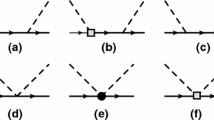Abstract.
We show that in the presence of massive particles, such as nucleons, the standard low-energy expansion, in powers of meson momenta and light-quark masses, in general converges in only part of the low-energy region. The expansion of the scalar form factor \(\sigma(t)\), for instance, breaks down in the vicinity of \(t=4M_\pi^2\). In the language of heavy baryon chiral perturbation theory, the proper behaviour in the threshold region results only if the multiple internal-line insertions generated by relativistic kinematics are summed up to all orders. We propose a method that yields a coherent representation throughout the low-energy region, while keeping Lorentz and chiral invariance explicit at all stages. The method is illustrated with a calculation of the nucleon mass and of the scalar form factor to order \(p^4\).
Similar content being viewed by others
Author information
Authors and Affiliations
Additional information
Received: 11 February 1999 / Published online: 18 June 1999
Rights and permissions
About this article
Cite this article
Becher, T., Leutwyler, H. Baryon chiral perturbation theory in manifestly Lorentz invariant form. Eur. Phys. J. C 9, 643–671 (1999). https://doi.org/10.1007/PL00021673
Issue Date:
DOI: https://doi.org/10.1007/PL00021673




